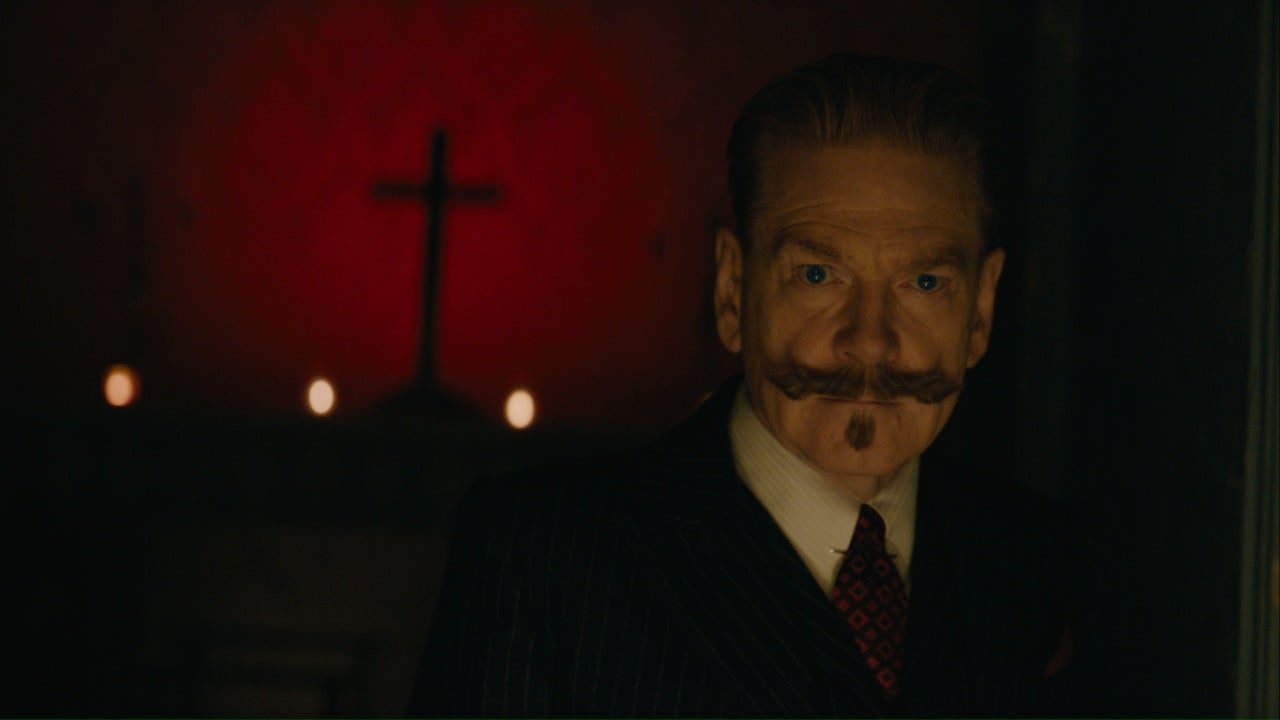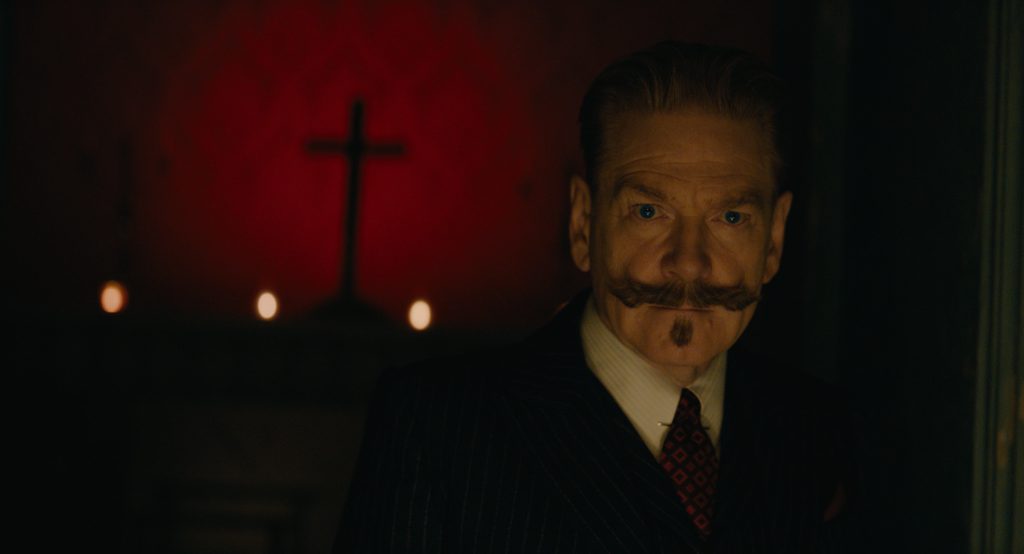A Haunting in Venice - Review
Kenneth Branagh continues to be Poirot’s biggest fanboy.

Kenneth Branagh has been directing Hercule Poirot films for six years now. At this point, his star-studded Agatha Christie adaptations feel more like passion projects than his own pseudo-biopic – the lukewarm Troubles-set drama Belfast – did, and his third entry in the mystery series is no exception. Loosely based on the poorly received late-era Christie novel Hallowe’en Party, A Haunting in Venice is a delightfully bizarre, raucously entertaining sequel. It plays like a standalone remake of some low-budget TV special that never was, while also building on the intimate mythology Branagh has built for his version of the extravagantly mustachioed detective, in a very good film that often threatens to be great, and outshines both of its predecessors.
What’s immediately clear about A Haunting in Venice is that it suffers from some over-eager trimming. Clocking in at a mere 103 minutes – nearly half an hour shorter than Death on the Nile – its introductory scenes and eventual character payoffs can’t help but feel rushed. However, once its chaotic, horror-tinged plot kicks into gear, the movie’s breakneck momentum forces its scattered pieces together, synthesizing them into some of the most viscerally enjoyable pulp imagery Hollywood has turned out this year.
A decade after the events of Murder on the Orient Express, a now-retired Poirot (Branagh) lives a life of contentment and isolation in Venice, thanks in large part to his Italian bodyguard, Vitale Portfoglio (Riccardo Scamarcio), who wards off paranoid civilians eager for the Belgian detective’s help by casually tossing them into Venetian canals. The extent to which Poirot no longer cares about sleuthing is brazenly funny. He’s a celebrity in hiding, having left his old life behind – that is, until his past comes a-knocking in the form of American author Ariadne Oliver (Tina Fey), a longtime friend and a Christie regular making her first appearance in this series. The bubbly novelist, who made her name writing books loosely based on Poirot, invites him to live life outside his self-imposed confines for one evening, at a Halloween party hosted by a friend, but the scribe’s true motives soon come to light.
In true Poirot fashion, “zere has been a merder” (or a possible suicide; few know for sure). But the victim – a young girl, Alicia Drake – has been deceased for a year. The party, it turns out, is to be the site of a séance performed by the mysterious, world-famous medium Joyce Reynolds (Michelle Yeoh), who Oliver is intent on exposing as a fraud with Poirot’s help. Little does anyone suspect, however, that the night’s mysteries are about to deepen, pulling Poirot back in just when he thought he was out, but with the added question of whether there’s something supernatural afoot.
The film whips between snappy humor and chilling silences with reckless abandon. While this makes for an off-kilter introduction – matched, of course, by Branagh’s signature Dutch angles, tipped over to their extreme – it’s the perfect vehicle for the tale at hand. The supporting characters all share various connections to the victim, from her despondent mother Rowena (Kelly Reilly), to her caring housekeeper Olga (Camille Cottin), to her fiery ex-fiancé Maxime (Kyle Allen), and finally, to her aloof doctor, Leslie (Jamie Dornan) and his creepily precious son Leopold (Jude Hill), who speaks as though he spends a little too much time surrounded by the elderly – both living and dead.
The guests’ proximity to death isn’t a new phenomenon, which separates this tale from Murder on the Orient Express and Death on the Nile. A Haunting in Venice is a ghost story, though whether that’s because there are spirits about is a case yet to be cracked. It’s a ghost story because nearly every character is burdened by grief of some ghastly shade, including Poirot, and much of what Branagh wants to convey about these characters resides in the unsaid.
The film whips between snappy humor and chilling silences with reckless abandon.
While the middling Murder on the Orient Express felt like a mystery on autopilot, its followup featured a pivotal third act story turn that made the film ferociously personal for Poirot: the death of a friend, which Branagh used as an aesthetic turning point as well. It pushed his second Christie outing into darker, more intimate, more atmospheric territory, with mournful eyes illuminated by dim warmth, and motives concealed by deep shadows. This time, he deploys this visual approach much sooner, thrusting Poirot and his various suspects into a realm where they’re surrounded by reminders of a sordid past. The house in which the plot unfolds has seen plenty of death, and is the rumored subject of a curse; whether or not the characters believe this, its history looms large over them in every scene, just as Poirot’s history keeps peeking through the margins of the frame.
In an age of shared universes, Branagh approaches A Haunting in Venice as its own episodic beast, with barely a reference to the previous films. However, having seen them – Death on the Nile in particular – makes the experience all the richer. It makes the weight that Poirot carries around his neck feel heavier, even though it’s easy to accept that a world famous detective would have seen his fair share of death. Branagh’s thoughtful performance more than sells the idea that he’s turned his back on the world, but given the last film’s conclusion (in which he opened himself up to love and vulnerability for the first time in years), the opening to A Haunting in Venice feels all the more melancholy, with the knowledge of what may have happened in between.
And then, there are the unspoken phantoms introduced through the specifics of Branagh’s adaptation . In addition to several major story changes – like making Joyce Reynolds an adult medium instead of a teenager at the party – returning screenwriter Michael Green transposes Christie’s story from England to Venice, and retrofits it from its 1960s setting to 1947. Venice was largely untouched by World War II, so it makes for a fittingly exotic getaway, but the effects of the war continue to linger for many of the characters, several of whom reveal their involvement in the conflict, and traumas they still carry. They see ghosts as well.
This thematic doom and gloom is complemented by some of the most overt and genuinely wackadoo horror filmmaking from any major contemporary director. It’s what makes A Haunting in Venice tick: Conversations are interrupted by brief cutaways to clanging doors and windows, an occurrence so frequent that it becomes part of the movie’s rhythm. When shots finally begin to hold on characters long enough for them to deliver monologues, Branagh’s staging always features some kind of ghostly shape or silhouette hovering un-subtly in the empty space around them (a familiar statue here, a bedsheet falling in an uncannily human shape there, and so on). And yet, it all works for what he’s trying to achieve. The characters may be attempting bear their souls, but the production design draws your gaze to something that clearly isn’t a spirit, yet resembles one enough that all you’re thinking about is the enormous, distracting figure in the corner of the room that feels as if it’s about to shake its arms and yell “Oogidy boogidy boo!”
The doom and gloom is complemented by some of the most wackadoo horror filmmaking from any major contemporary director.
Re-teaming with cinematographer Haris Zambarloukos, Branagh’s camera work is joyfully animated (for reasons eventually revealed), between uncomfortably askew closeups, gratuitous use of actor-mounted “SnorriCam,” and wide lenses that warp the features of the darkened hallways where people seem fated to die. In the process, the movie’s most horror-flavored moments become ludicrously fun, punctuated by dry wit from Poirot, who’s forced to confront not only his comrades, but his own perspective.
Unfortunately, no matter how well the actors sell the underlying story, the same rapid-fire editing that accentuates the mystery’s momentum ends up knee-capping much of its personal drama and the characters’ relationships, to the point that the “who” part of the “whodunit” ceases to matter as much as the question of how this case will impact Poirot and his beliefs. And yet, this is precisely why Branagh’s take on Poirot works as well as it does. He cares more deeply for this character than anyone save perhaps Christie herself, and it shows more clearly in A Haunting in Venice than it has before.
The Verdict
An off-kilter horror-comedy told with breakneck momentum, A Haunting in Venice is a wild stylistic departure from Kenneth Branagh’s previous Poirot mysteries. However, it continues the series’ strange evolution as a tribute to the iconic Belgian sleuth; Branagh cares more about Poirot than any living person, and it shows.
A Haunting in Venice Review

